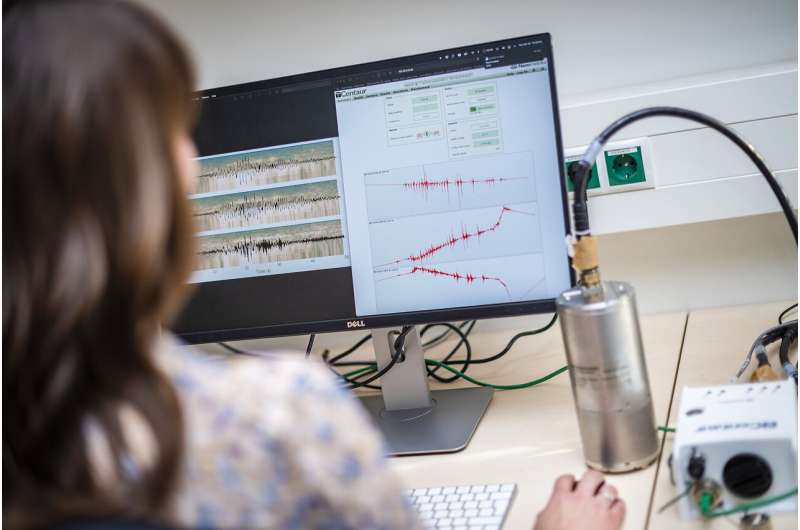What happens underground during hydraulic fracturing

A research team from Ruhr-Universität Bochum (RUB) and McGill University in Montreal is investigating what exactly happens underground when the earth in western Canada shakes as a result of hydraulic fracturing activities. The team, headed by Bochum-based Professor Rebecca Harrington, wants to fundamentally understand how earthquakes occur—whether human induced or natural. "The hydraulic fracturing process is something like a scaled-up laboratory experiment for us," explains Harrington, who heads the Hydrogeomechanics Group at RUB. "We see what happens when the subsurface is exposed to controlled stress conditions—under natural conditions changes in stress would be much more difficult to study." RUB's science magazine Rubin reports on the findings.
For the purpose of their study, the researchers evaluate records of natural and human induced earthquakes. One of the many data sources are the earthquakes triggered by hydraulic fracturing in a roughly 50 by 50 kilometer area in the Western Canada Sedimentary Basin. The process is used to tap oil or gas deposits that lie deep underground. A mixture of water, sand, and weakly concentrated hydrochloric acid is injected into the ground at high pressure to create cracks in the rock and make it more permeable to extract the gas or oil more easily. This can repeatedly cause earthquakes.
Fluids move not quite as expected
In 2018, a magnitude 4.5 quake occurred very early in the hydraulic fracturing process, when hardly any fluid had been injected. "This shows that fluids are moving underground in ways we wouldn't expect," says Harrington. The RUB team analyzed this earthquake and several of its aftershocks, the largest of which still reached magnitudes of 4.2 and 3.4, together with their colleagues at McGill University. The two institutions have set up 17 seismic stations in the Western Canada Sedimentary Basin and have thus access to a comprehensive data network.
Using these records, the scientists reconstructed the sources of the various quakes and how they had spread underground. They linked the data with information about the hydraulic fracturing process and the nature of the subsurface and the interactions of the fluids with the rock. By means of computer simulations, they modeled the forces that had acted in the subsurface during the quakes. The conclusion: "Presumably there was a geologically young fault zone in the subsurface, i.e. a network of fractures in the Earth's crust, which acted as a natural pathway for fluids. The hydraulic fracturing fluid could then flow through the fracture network like a channel," as Rebecca Harrington describes the process. The fluid flow thus quickly reached the underlying fault, which disturbed the stress structure in the subsurface and triggered an earthquake that was stronger than expected.
Analysis of 8,200 earthquakes is in progress
The German-Canadian team has begun analyzing around 8,200 earthquakes recorded by seismic stations in western Canada between July 2017 and September 2020. The researchers showed that many earthquakes occur at locations where natural geological faults exist in the subsurface with which fluids interact. They also proved that these faults are optimally aligned in the stress field of the Earth's crust to trigger earthquakes.
"The earthquakes do originate from industrial activities, but once initiated, the geological faults behave pretty much like an earthquake of natural origin," concludes Rebecca Harrington. "Overall, our studies suggest that there are no fundamental differences between natural earthquakes and earthquakes triggered by hydraulic fracturing. Everything we learn about induced earthquakes can also help us understand natural earthquakes—and hopefully one day help us minimize impacts to people and infrastructure from earthquakes."
More information: A. F. Peña Castro et al. Stress Chatter via Fluid Flow and Fault Slip in a Hydraulic Fracturing‐Induced Earthquake Sequence in the Montney Formation, British Columbia, Geophysical Research Letters (2020). DOI: 10.1029/2020GL087254
Marco P. Roth et al. High-Resolution Imaging of Hydraulic-Fracturing-Induced Earthquake Clusters in the Dawson-Septimus Area, Northeast British Columbia, Canada, Seismological Research Letters (2020). DOI: 10.1785/0220200086
Journal information: Seismological Research Letters , Geophysical Research Letters
Provided by Ruhr-Universitaet-Bochum















